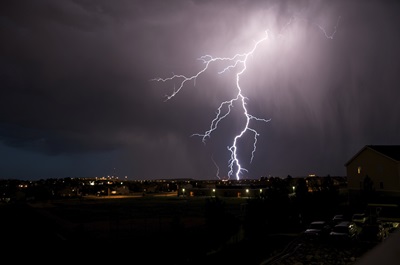Thunder, lightning, and tornadoes emergency preparedness

Thunderstorms can bring heavy rains, strong winds, hail and lightning. A thunderstorm is formed from a combination of moisture, rapidly rising warm air, and a force capable of lifting air such as a warm or cold front, a sea breeze, or a mountain. All thunderstorms contain lightning. Thunderstorms may occur singly, in clusters, or in lines. Thus, it is possible for several thunderstorms to affect one location in the course of a few hours. Some of the most severe weather occurs when a single thunderstorm affects one location for an extended time.
Lightning is an electrical discharge that results from buildup of positive and negative charges within a thunderstorm. When the buildup becomes strong enough, lightning appears as a "bolt." This flash of light usually occurs within the clouds or between the clouds and the ground. A bolt of lightning reaches a temperature approaching 50,000 degrees Fahrenheit in a split second. The rapid heating and cooling of air near the lightning causes thunder. Lightning is a major threat during a thunderstorm.
Although rare in our region, tornadoes are the most violent weather phenomena known. A tornado is characterized by a twisting, funnel-shaped cloud. The most severe tornadoes can produce winds in excess of 250 MPH. Tornadoes are produced by thunderstorms and occur when cold air overrides a layer of warm air, forcing the warm air to rise rapidly. Five tornadoes have been sighted in King County since 1950.
It is important to be prepared for all potential severe storm hazards, regardless of frequency.
Prepare for thunder, lightning, and tornadoes
- Pick a "safe place" in your home where family members can gather during a thunderstorm or tornado. This should be a place where there are no windows, skylights, or glass doors which could be broken by strong winds, flying debris, or hail.
- Pay attention to weather clues. Look for darkening skies, flashes of lightning, or increasing wind which may be signs of an approaching thunderstorm. These same conditions, along with large hail, a loud roar, and a dark, low-lying cloud are signs of a tornado. Be prepared to take shelter immediately.
- Listen for sounds of thunder. If you can hear thunder, you are close enough to the storm to be struck by lightning. Look for places you might find shelter.
During a thunder, lightning, or tornado event
- Stay informed. Monitor local news and information on your TV, mobile device, or battery-operated radio. Follow emergency instructions.
- Stay indoors, if possible, and go to your home or office designated "safe place."
- Unplug appliances and electronics - electrical surges from lightning can damage them.
- Avoid using TVs, landline telephones, bathtubs, water faucets, and sinks because wiring and metal pipes can conduct electricity if lightning strikes. Leaving electric lights on, however, does not increase the chances of your home being struck by lightning.
- If you are outside during a thunder or lightning storm: Take shelter in a building or sturdy, enclosed structure. Avoid open gazebos, picnic shelters, and golf carts which are unprotected. If no buildings are available, take shelter in an enclosed vehicle with the windows closed. As a last resort, go to a low-lying, open place away from trees, poles, fences, or metal objects. Squat low to the ground with your hands on your knees. Do not lie flat on the ground, as this will make you a larger target for lightning.
- If you are driving in a thunderstorm with heavy rain, pull safety onto the shoulder of the road, away from trees and tall objects. Turn on your car's emergency flashers and remain in your vehicle until the storm passes.
- If you are outdoors during a tornado: Take immediate shelter in a nearby building or sturdy, enclosed structure. If none is available, lie in an area noticeably lower than the level of the roadway. Cover your head with your arms and a blanket, coat, or other cushion if possible. Do not get under an overpass or bridge; you are safer in a low, flat location.
- If you are driving during a tornado: Take immediate shelter in a nearby building or sturdy, enclosed structure. If your vehicle is hit by flying debris, pull over and park. Keep your seatbelt on and cover your head with your arms and a blanket or coat.
- If someone is struck by lighting, call 9-1-1 immediately. If you are trained and if appropriate, administer first aid and CPR.

 Translate
Translate